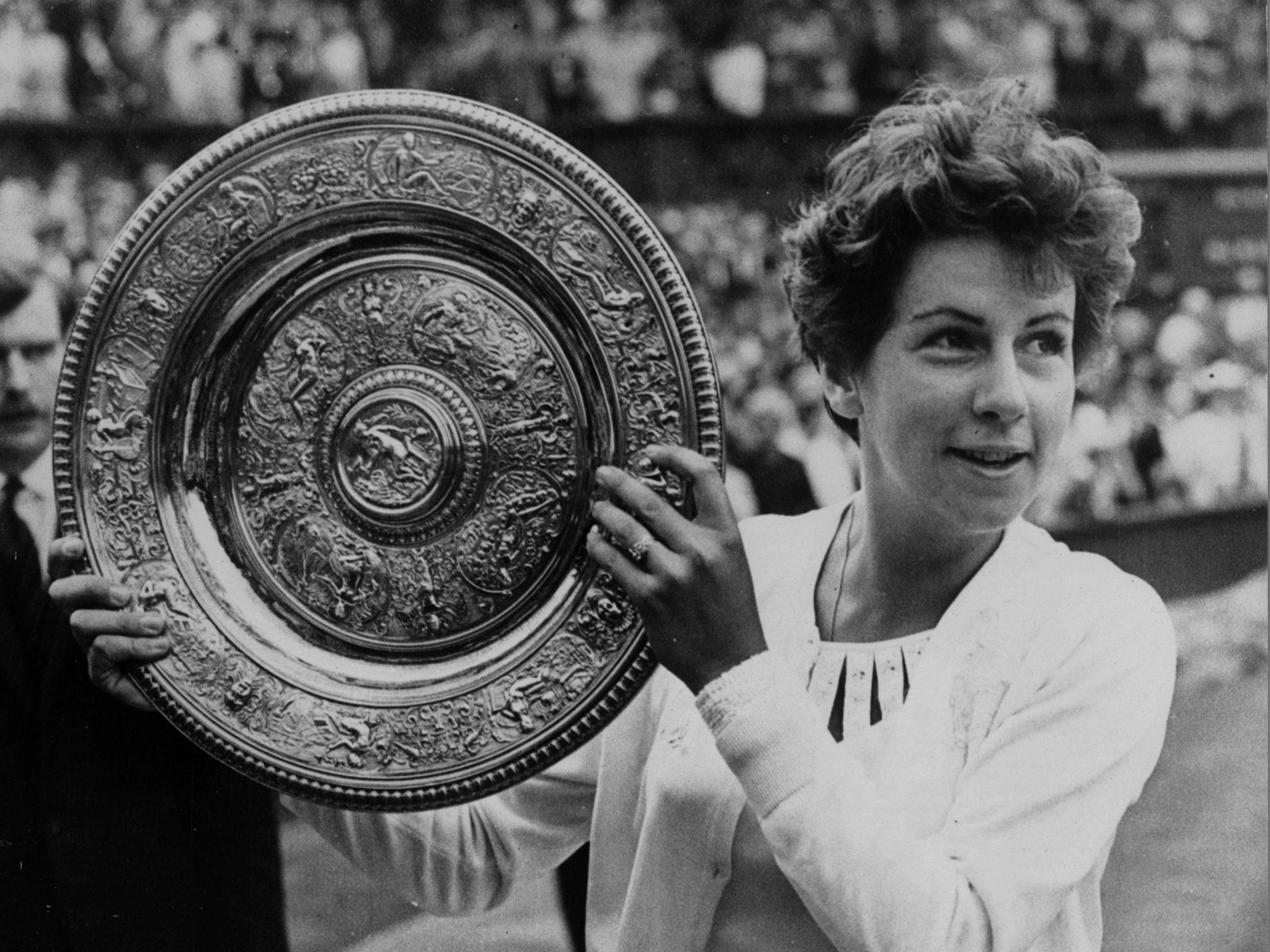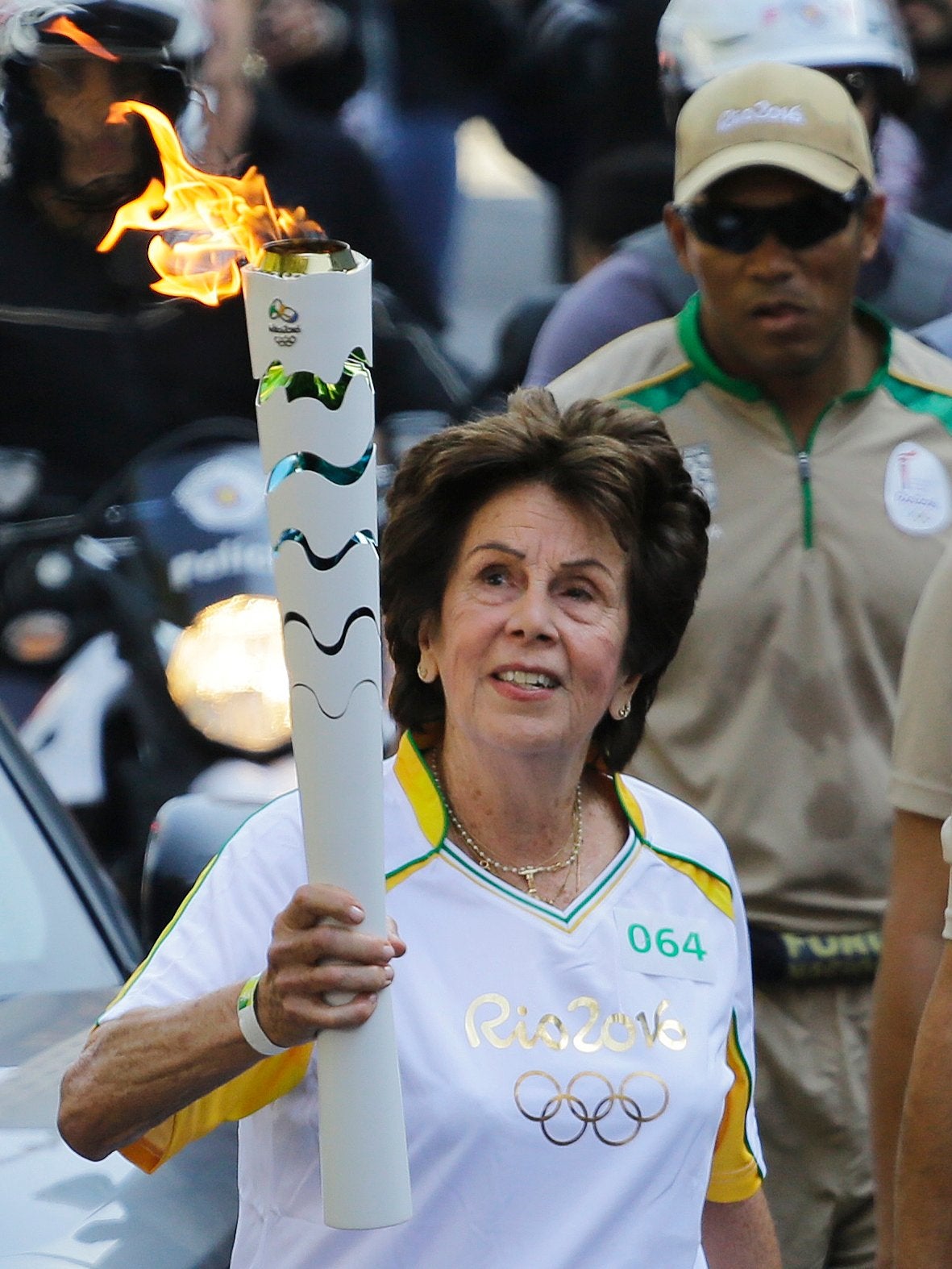Maria Bueno: Four-time Wimbledon winner who became a Brazilian tennis legend
The female tennis pioneer won seven Grand Slam singles and captured the world’s attention with her grace and style

Maria Bueno was to Brazilian tennis what Pele was to football – a player of exceptional talent who captured the world’s imagination in the 50s and 60s.
The much-loved “tennis ballerina”, known for her graceful manner, won three Wimbledon singles titles and four US Opens. She won a further 11 Grand Slam titles in doubles and one in mixed doubles.
She helped raise the profile of women’s tennis, becoming an international superstar in an era when most women’s matches were played on the outer courts. US champion Billie Jean King said of her: “Maria was a big star who caught the imagination and interest of the fans at a time when the men took centre stage. She helped lay the groundwork for what was to come.”
In a career cut short by injuries that prevented Bueno carrying her success into the professional era, she became the world number one just after her 20th birthday, holding it a further three times.
In 1959, Bueno become the first non-American woman to win Wimbledon and the US Open in same season. She made further history in 1960 by becoming the first ever woman to win all four double Grand Slam titles in a calendar-year – three of them with American champion Darlene Hard and one with British champion Christine Truman.
Of her Wimbledon appearances, commentator John Barrett wrote: “We were treated to three regal wins from the artistic racket of the elegant queen of Brazilian tennis. Here was poetry in motion whose every movement combined the grace of a ballet dancer with the controlled power of a top gymnast.”
In 1964 Bueno, returning to Wimbledon after injury, surprised the crowd and shocked the All England Club Committee, who to this day insist on all-white tennis attire, wore a white Ted Tinling dress that had a pink underskirt and matching pink underwear.
“There was an audible gasp from one end of the court,” Bueno recalled years later. “The people at the other end didn’t know why, until I changed ends and served from there.”
Born in Sao Paulo, in 1939, Maria Esther Andion Bueno was from a close, middle-class family with both parents, Pedro, a businessman, and Esther, keen members of the local tennis club – which was opposite their home. Handling a used racket, aged six, she played regularly against her brother Pedro, and weekends tended to centre around the family playing at the Clube de Regales Tiele.
Although slight in build and stature, Bueno developed her explosive service action from studying photographs of the 1920s US champion “Big Bill” Tilden, and in contrast to her brother, a baseliner, Bueno became a net-charger with an almost impatient, aggressive game that incorporated an array of killer shots and scorning percentage play.
Training and playing against brother Pedro, who went on to play the Davis Cup for Brazil, and Brazilian international Armando Vieira, her mentor, she soon outshone her brother and started winning junior tournaments in her early teens. “I had a lot of natural talent, but I had to work hard too,” she recalled. She attributed her speed on the court to having trained with men.
In 1957, having travelled unaccompanied to Miami, Florida, with a ticket donated by her club, she won the Orange Bowl, considered the world’s most important junior tournament. This whirlwind success continued with her claiming 14 of the 15 titles available on the Caribbean circuit.
The following year, she spread her wings and toured Europe, offering a glimpse of her precocious talent and captivating audiences on the centre courts of Foro Italico in Rome, where to the surprise of many, she beat the best English and Australian players and won the Italian championship, causing “an absolute sensation” and leaving the Romans chanting rapturously “Bueno, Bueno, Bueno!”

Fellow prodigy and friend Christine Truman recalled: “The Italians went wild for her exotic looks and glamour. She was the most graceful player I ever saw on court, with pace rather than power, and a serve like a rocket thanks to her wonderful timing.”
Bueno announced herself to the tennis world in 1958 when she made her debut at Wimbledon and sensationally won the women’s doubles with Althea Gibson, a trailblazing African American who dominated the women’s game in the late 50s.
One commentator described Bueno as being “like an exotic siamese cat as she roamed the court. She was sinuous, sensuous and feminine… and became known as the queen of Wimbledon.”
Following the success of her first trip to Europe, Bueno established her dominance when she swept all aside to win the 1959 Wimbledon singles title at her second attempt, beating Darlene Hard 6-4, 6-3, before travelling to Forest Hills and defeating Christine Truman 6-1, 6-4 to take the US title. With her graceful style of play and stunning looks, the press recognised her as “queen of the game”.
Back home, Brazil’s mail service issued a postage stamp honouring her Wimbledon title and was touted as the heir apparent to Gibson, receiving the 1959 Associated Press Female Athlete of the Year Award.
Bueno amassed an astonishing 65 singles titles, 90 doubles titles and 15 in mixed doubles, while finishing runner-up in 45 other competitions and reaching the quarter finals in each of the first 26 majors she played. “The moment I have to think about my tennis, I cannot play,” she explained, in a statement that seemed to make coaching manuals redundant.
All but one of Bueno’s major singles titles were won in straight sets; Brit Margaret Court, one of her biggest singles rivals, extended her to three sets (6-4,7-9, 6-3) in a memorable final at Wimbledon in 1964, which earned Bueno her third and final championship on Centre Court – it was her most satisfying. She was a finalist there in 1965 and 1966, losing to Court and the ever-improving Billie Jean King.
King, who later helped start a women’s professional tennis tour, said of Bueno: “She was one of the players who made tennis less of a man’s game.”
Her career was hampered, and ultimately curtailed, by injuries and illness, including being bed-bound for eight months in 1961 due to hepatitis.
Her last major title came in 1968, when she won the doubles title at the US Open alongside Court.
With the “open era” starting the same year, Bueno was forced to undergo a series of operations, returning briefly to the circuit in 1974 she won the Japan Open, bringing her biggest payday of her mainly amateur career – $6,000 (£4,550).
Her last singles appearance at Wimbledon came in 1977, when she lost to King in the third round. The following year she was inducted into the International Tennis Hall of Fame.
In retirement, she remained a national treasure and was a regular commentator on Brazilian television coverage at Wimbledon, the US Open and other majors as well as the BBC World Service. In 2015, the centre court at the Olympic Tennis Centre in Rio de Janeiro, where Andy Murray won his second Olympic gold medal, was named after her and she carried the Olympic torch in 2016.
Bueno continued playing and last year at Wimbledon, after finishing her TV commentary duties, could be found playing on the outside courts.
In Brazil, she was treated like royalty winning numerous accolades and presidential decrees. A statue was built in her honour and, despite some strong competition from the likes of Guillermo Vilas and Gustavo Kuerten, Bueno was named the best 20th century Latin American tennis player.
Maria Bueno, tennis player, broadcaster, born 11 October 1939, died 8 June 2018
Join our commenting forum
Join thought-provoking conversations, follow other Independent readers and see their replies
Comments